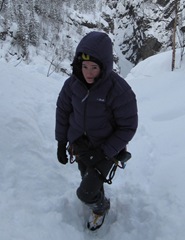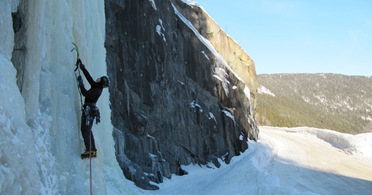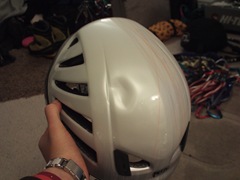Our second week in Rjukan included ascents of a couple of the longer routes in the area along with a number of other shorter routes (including an unexpected gem in the Lower Gorge called Swiss Army – a WI4/5 depending on which line you take up it).
I’m going to use this post to focus on what were (for me) the two big routes – Tjønstadbergfossen and Trappfoss. I will admit now that I didn’t think Tjønstad really warranted the grade it is given of WI4, its only maybe WI3+ at most, although you could make it harder if you wanted to – it is a huge wide icefall above Rjukan town itself, and one of the few we did with a 20-30min walk-in (admittedly it only took that long because I’m slow and unfit when it comes to walking uphill with a sack full of gear and ropes!). Trappfoss was an altogether more serious route for us, probable due in no small part to the conditions in which we chose to climb it (I say we, but I wasn’t all that keen myself actually – the amount of snow that had settled on it during the week’s flurries didn’t exactly look great, so I blame Patrick for what became one of the most serious and scary ascents I’ve done so far).
Tjonstadbergfossen, Rjukan Centre, WI4(?):
We had great fun on this one, climbing in parallel with a pair of Irish climbers we met at the base of the route (and part of a group we kept running into for the rest of the week!). Ok so most of it probably wasn’t much harder than WI2/3, with only one real steep pitch, but the ice was a touch rotten most of the way due to the fact that this icefall is south facing and catches the sun during the afternoon.
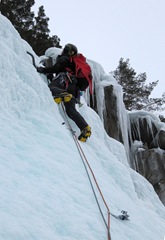
Some great views back down to the town from the belay stances!
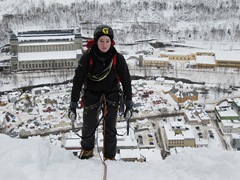
The final pitch isn’t always in condition according to the guidebook, but it was for us. Probably only WI2 or WI3 at most but with some rather lengthy run-outs and curtains of hanging icicles to avoid (and pray they don’t fall on you), this pitch was just good fun and of course landed you at the top of the route – always the best place to be!
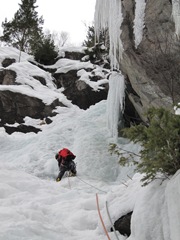
Swiss Army, Lower Gorge, WI4/5:
Ok so this was another single pitch-er but a real gem that we both enjoyed. I need to say thank you to Patrick for letting me take this one, even though he’d spotted it earlier in the trip and wanted to do it himself. I had been feeling rather cruddy that day and needed a mental boost – and this was it. Great fun and in great nick, the guidebook only gives this route 2 stars but I’d definitely give it 3 – a wonderful steep icefall start, followed by an easy ledge system then some entertaining iced up slabs and short stepped falls. This route packed a whole load of different climbing experiences into one short pitch – brilliant.
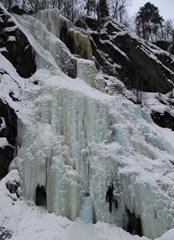
The trip finale: Trappfoss, Upper Gorge, WI4:
This route has been on both mine and Patrick’s wish lists since we first laid eyes on it last year – a huge frozen waterfall about half way along the Upper Gorge, Trappfoss can’t help but catch any climber’s eye should they glance its way. The first picture I’ve included here is a view of it from across the other side of the gorge (actually from right next to the route Svingfoss) – Trappfoss is the huge fall in the centre of the picture, with the altogether harder proposition of Juvsøyla (WI6) to its left. I should also mention that this picture was taken before we had an additional 4-6inches of snowfall…
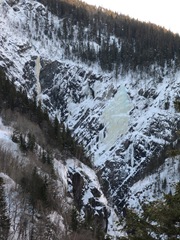
This next picture is me at the end of the first pitch, and just before the start of the main icefall, you can see just how much snow had settled on the route, and believe me it did not make things any easier, far from it. It hardly looks like a pitch of climbing I’ve just done does it? More like a wander up an easy angled snow ramp yes? No. That pitch was 4 inches of loose sugary powder over hard ice, and whilst it wasn’t particularly steep (although steeper than it looks here), it was a real calf killer! At this point we had thought that a second short pitch would land Patrick on a good ledge on the right hand side of the icefall and should only have taken 10 minutes or so, but unfortunately we were wrong. As I stood there belaying off of a cruddy old Abalakov and a dodgy ice screw, I didn’t bother putting on my down jacket (despite it being –10 degrees or so), simply because we had both thought it would be a short ‘filler’ pitch to gain a better stance. Wrong. Patrick led an epic and scary powdery, slushy rotten traverse that took rather a long time (big respect on that traverse though – the ice on the crux was completely rotten and unprotectable!).
To cut a long story short, I began to think I was going to freeze to death on that belay (ok so maybe an overstatement, but remember – I have suffered the effects of severe hypothermia before and was beginning to worry about it happening again). I did eventually decide to put my lovely duvet jacket on (major faff to do, hence not bothering before this point), but by this time I was too cold for it to be of much use. This meant that when it was my turn to follow the pitch I was incredibly cold and miserable, and about to suffer the worst bout of hot aches I have ever had (I really didn’t know it could even be that painful – I was in tears, twice – once for each hand). Also, I should mention that I don’t like traverses. I’m not keen on leading them but for some reason I’m even less keen on seconding them, and this was a doozy. Unprotected, slushy, rotten ice over a big drop. The ice was so bad in places your picks and crampon points just sliced through it. A real ‘big balls’ lead if ever I’d seen one!
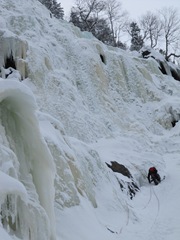
Ok so the horrendous traverse over (us both wondering why we hadn’t just taken the steep wall direct – of course the reason for this was that we’d become disorientated and had thought we were heading for a stance that didn’t exist!), I was cold, miserable and my hands were burning like I’d just dipped them in acid. Of course I led next. I couldn’t bear the thought of having to stand at that belay and freeze again, so despite the next pitch being the steep one (no pictures I’m afraid), I took it. After all, the ice looked better and there was no way it could be as bad and rotten as the stuff we’d just come up, could it?
Well you can guess can’t you? It was sh*t. The ice was either brittle and sugary, wet and barely more solid than a slush puppy, or covered in a foot of powder. The steep (WI4) section was some of the worst ice I’ve ever climbed on – each axe placement had to be carefully cleared and tested, the screws I placed would probably have pulled out by hand, and despite the great level of care I was taking (whilst muttering to myself: “rule number one*, rule number one”), I still managed to rip a couple of axe placements. Oddly though I didn’t panic or gibber at all – I was in a real zen like state where everything moved slowly and in control, where even the explosive force of an axe pick ripping during testing hardly even shook or surprised me.
Once the steep bit was over things looked like they would improve as I reached a system of ledges leading to the top – sadly that foot of powder lying on top of everything meant that the ice beneath was either mush or would shatter, and that was only once you had dug down through it, or chosen to swim up it (I kid you not – had I not had so many protective layers on I would have ended up with snow in my bra and pants).
Ok enough of the melodrama – obviously neither of us fell off or froze, in fact here we are, looking very relieved at the top after I’d managed to pull 120m of completely frozen ropes through the belay device with Patrick on the end:

I must say though, although our ascent of Trappfoss ranks as one of the worst ice climbing experiences I’ve ever had, it is also likely to be one of the most memorable, and a performance that I am truly proud of. See, most of the time I’m a real wuss, and can turn into a gibbering wreck for no reason when things are perfectly safe (hell I even have days where I wuss out of things on a top rope for goodness sake, and I’m not just talking ice here), but when things get really serious I know I can pull it out of the bag – everything just came together that day and I was a true cool headed climber.
*Rule number one of ice climbing: do NOT fall off.
